Potrebujeme váš súhlas na využitie jednotlivých dát, aby sa vám okrem iného mohli ukazovať informácie týkajúce sa vašich záujmov. Súhlas udelíte kliknutím na tlačidlo „OK“.
ASTM E498/E498M-11
Standard Practice for Leaks Using the Mass Spectrometer Leak Detector or Residual Gas Analyzer in the Tracer Probe Mode
Automaticky preložený názov:
Štandardná prax tesnosť hmotnostného spektrometra netesností alebo zvyškového plynu analyzátor Tracer režime Probe
NORMA vydaná dňa 1.7.2011
Informácie o norme:
Označenie normy: ASTM E498/E498M-11
Poznámka: NEPLATNÁ
Dátum vydania normy: 1.7.2011
Kód tovaru: NS-46990
Počet strán: 5
Približná hmotnosť: 15 g (0.03 libier)
Krajina: Americká technická norma
Kategória: Technické normy ASTM
Kategórie - podobné normy:
Anotácia textu normy ASTM E498/E498M-11 :
Keywords:
bell jar leak test, bomb mass spectrometer leak test, helium lead testing, helium leak test, leak testing, mass spectrometer leak testing, sealed object mass spectrometer leak test, Bell jar leak test, Bomb mass spectrometer leak test, Helium leak testing, Leak testing--mass spectrometer leak detector (MSLD), Mass spectrometer leak detector (MSLD), Probe methods, Residual gas analyzer (RGA), Sealed object mass spectrometer leak test, Tracer probe mode, Vacuum testing
Doplňujúce informácie
| Significance and Use | ||||
|
Test Method A is the most frequently used in leak testing components which are structurally capable of being evacuated to pressures of 0.1 Pa (approximately 10−3 torr). Testing of small components can be correlated to calibrated leaks, and the actual leak rate can be measured or acceptance can be based on a maximum allowable leak. For most production needs acceptance is based on acceptance of parts leaking less than an established standard which will ensure safe performance over the projected life of the component. Care must be exercised to ensure that large systems are calibrated with reference leak at a representative place on the test volume. Leak rates are determined by calculating the net gain or loss through a leak in the test part that would cause failure during the expected life of the device. Test Method B is used for testing vacuum systems either as a step in the final test of a new system or as a maintenance practice on equipment used for manufacturing, environmental test or for conditioning parts. As the volume tends to be large, a check of the response time as well as system sensitivity should be made. Volume of the system in liters divided by the speed of the vacuum pump in L/s will give the response time to reach 63 % of the total signal. Response times in excess of a few seconds makes leak detection difficult. Test Method C is to be used only when there is no convenient method of connecting the leak detector to the outlet of the high vacuum pump. If a helium leak detector is used and the high vacuum pump is an ion pump or cryopump, leak testing is best accomplished during the roughing cycle as these pumps leave a relatively high percentage of helium in the high vacuum chamber. This will obscure all but large leaks, and the trace gas will quickly saturate the pumps. |
||||
| 1. Scope | ||||
|
1.1 This practice covers procedures for testing and locating the sources of gas leaking at the rate of 1 × 10−8 Pa m3/s (1 × 10−9 Std cm 3/s) or greater. The test may be conducted on any object to be tested that can be evacuated and to the other side of which helium or other tracer gas may be applied. 1.2 Three test methods are described: 1.2.1 Test Method A—For the object under test capable of being evacuated, but having no inherent pumping capability. 1.2.2 Test Method B—For the object under test with integral pumping capability. 1.2.3 Test Method C—For the object under test as in Test Method B, in which the vacuum pumps of the object under test replace those normally used in the leak detector. 1.3 Units—The values stated in either SI or std-cc/sec units are to be regarded separately as standard. The values stated in each system may not be exact equivalents: therefore, each system shall be used independently of the other. Combining values from the two systems may result in non-conformance with the standard. 1.4 This standard does not purport to address all of the safety concerns, if any, associated with its use. It is the responsibility of the user of this standard to establish appropriate safety and health practices and determine the applicability of regulatory limitations prior to use. |
||||
| 2. Referenced Documents | ||||
|
Podobné normy:
Historická
1.5.2011
Historická
1.6.2011
Historická
1.12.2011
Historická
1.8.2013
Historická
1.8.2013
Historická
1.6.2012


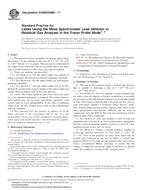
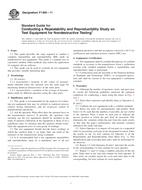 ASTM F1469-11
ASTM F1469-11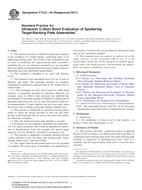 ASTM F1512-94(2011)..
ASTM F1512-94(2011)..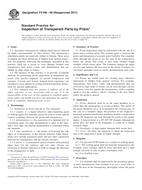 ASTM F2108-06(2011)..
ASTM F2108-06(2011)..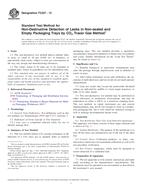 ASTM F2227-13
ASTM F2227-13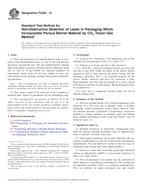 ASTM F2228-13
ASTM F2228-13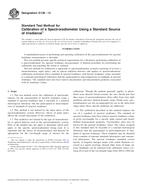 ASTM G138-12
ASTM G138-12
 Cookies
Cookies
